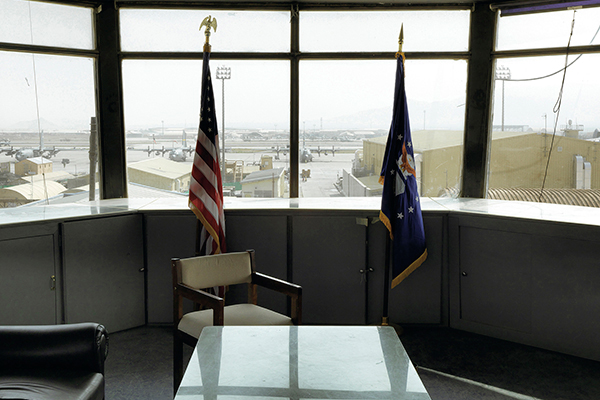The Brighton Photo Biennial 2012
Agents of Change: Photography and the Politics of Space
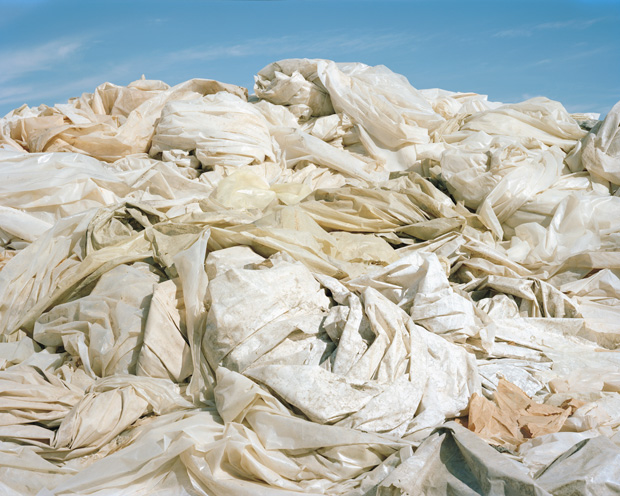
Corinne Silva, Plastic Mountain I, plastic recycling plant, from Badlands, 2008–11.
© Corinne Silva
To Londoners, the seaside town of Brighton is synonymous with crowds, fun-fair rides, and ice cream. Close enough for a day trip, the very idea of it shimmers carefree. On the train there, perusing the brochure for the Brighton Photography Biennial, I’m reminded that away from the beach and the jauntiness it is also an enclave of progressive values, counterculture, and dissent.
Addressing some of the most pressing issues of the past few years, Agents of Change: Photography and the Politics of Space appears to be a biennial at the right time in the right place. Its title suggests the belief that photography can make a difference. Ranging over the financial crisis, street-level poverty, the Arab Spring, the domestic war on terror, the rich-poor divide, the effects of globalization, drone warfare, and Occupy and other protest movements, a total of fourteen shows consider how the camera, rather than just being an instrument of mediation, might sometimes take hold of reality instead.
The exhibition Uneven Development pairs the work of two photographers who examine ways the division of space creates and reinforces inequalities. In his extended photo essay Cairo Divided, published in the Guardian in 2011, Jason Larkin documents the construction of new gated suburbs around Cairo. Distributed in Egypt as a free newspaper, Larkin’s work, accompanied by the Guardian’s Jack Shenker’s text, is a first-rate example of nuanced, deep-digging journalism.
For her series Imported Landscapes, Corinne Silva pasted her own photographs of Moroccan landscapes across billboards in southern Spain. By compressing the landscapes of these neighbouring countries into a single frame, Silva forces attention onto their interwoven histories, economies, and geographies. The theme of shifting boundaries brought on by globalization runs through her conceptually beguiling work. Making unashamed use of the local Mediterranean light, her pictures are compositionally flawless. Next to them, Larkin’s journalistic aesthetic looks almost out of place.

Trevor Paglen, Large Hangars and Fuel Storage; Tonopah Test Range, NV; Distance approx.18 miles; 10:44 am, 2005.
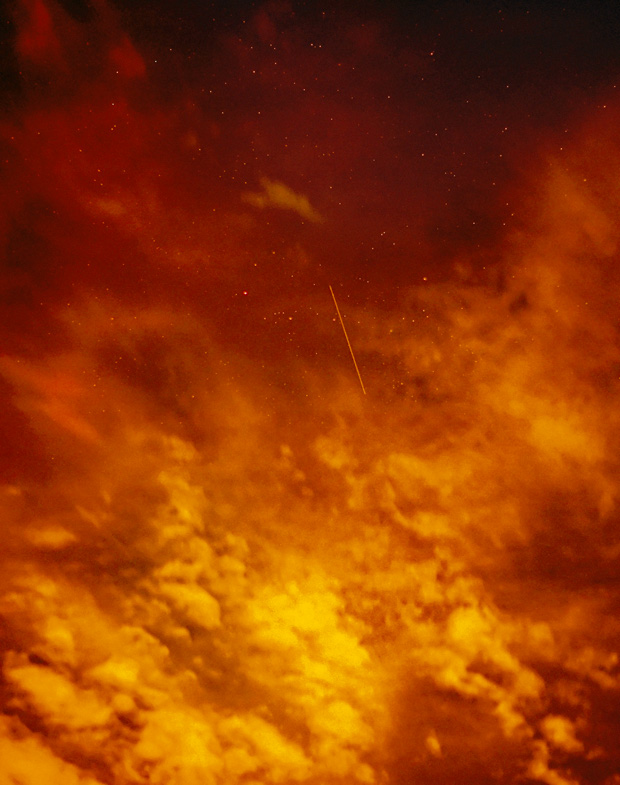
Trevor Paglen, KEYHOLE 12-3 (IMPROVED CRYSTAL) Optical Reconnaissance Satellite Near Scorpio (USA 129), 2007 © Trevor Paglen
A short walk away, The Beautiful Horizon is a photographic collaboration between artists Julian Germain, Patricia Azevedo, Murilo Godoy, and a group of young Brazilian street people. The results, adroitly presented in a church-turned-gallery, provide an unexpurgated glimpse into the lives of some of the planet’s most disadvantaged citizens. The project, like many others, attempts to give a voice to the dispossessed, though whether, as the catalogue claims, “the project demonstrates how photography can intervene in the urban landscape” remains open to question. True to the spirit of the biennial, The Beautiful Horizon is predicated on a Panglossian faith in photography: a hope that it can make things better. For without hope, what remains?
Perhaps the answer, if there is one, can be found in the work of Trevor Paglen, an artist who specializes in what has been termed counter-surveillance. Using astronomical lenses with focal lengths of up to 7,000 mm, he photographs secret U.S. military installations as far as sixty-five miles away. The grainy pictures show Predator drones skulking in their hangars. In perhaps the most arresting image the tiny silhouette of a drone is pinned, insect-like, against the clouds. For his series The Other Night Sky, Paglen tracked classified military intelligence satellites as they passed overhead. The results, reminiscent of photographs of outer space, are as beautiful as they are chilling.
Returning power’s gaze is a theme that runs throughout the biennial. Edmund Clark’s Control Order House is another project in which photography becomes a battle zone. After months spent negotiating with the United Kingdom’s Home Office, Clark was finally allowed to take pictures of the interior of a house where a terrorist, suspect subject to a Control Order, was living. Rather than being arrested, a “controlled person” is obliged to live in government-designated accommodations and must follow a strict set of rules. Similarly, the photographs Clark was permitted to take reveal nothing about either the suspect or the house’s true identity. The resulting images are bland—impersonal rooms with no distinguishing features—visual counterparts of the existence that controlled persons are obliged to lead. Compulsory immersion in English suburban life may be one way of dampening the fires of jihadism, but consider that alongside this forced relocation you also live under constant surveillance. With cameras possibly everywhere, hemmed in by myriad regulations, the controlled person must internalize authority’s gaze, self-correcting at every step.
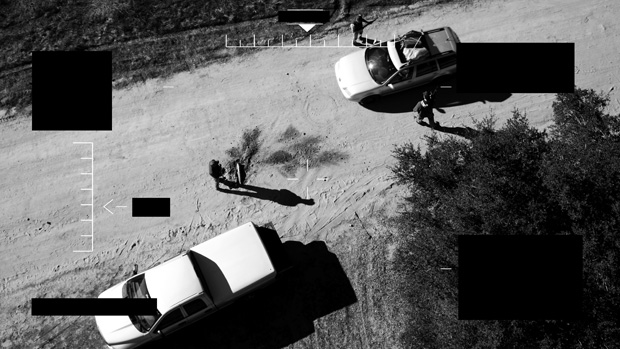
Omer Fast, from 5000 Feet is the Best, digital film, 30 minute loop, stills by Yonn Thomas, 2011. © Omer Fast
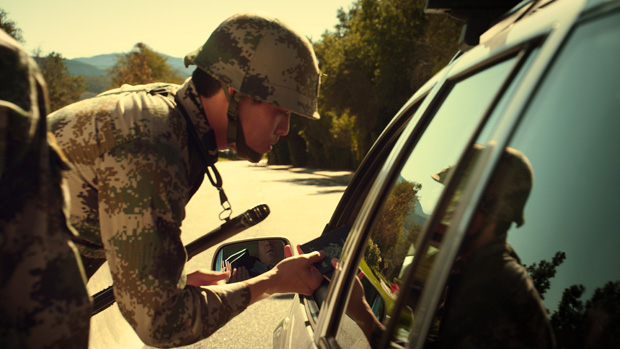
Omer Fast, from 5000 Feet is the Best, digital film, 30 minute loop, stills by Yonn Thomas, 2011. © Omer Fast

Omer Fast, from 5000 Feet is the Best, digital film, 30 minute loop, stills by Yonn Thomas, 2011. © Omer Fast
While such an exercise of power might be far-reaching, it is Omer Fast’s film about the effects of drone warfare that truly demonstrates the camera’s full force. If we can all imagine how drone strikes impact upon their targets, then Five Thousand Feet Is Best also focuses on the drones’ operator-pilots, splicing together restaged and documentary interviews alongside fictionalized scenes. In voiceover narration, we hear an ex-pilot complain how after his first “kill” he began to suffer from “virtual stress,” bad dreams and loss of sleep, brought on not only by the disconnection that characterizes such remote assassinations, but perhaps also by the overload of grisly information furnished by the powerful cameras on the drones. “What it does is lock on those pixels,” he says, talking of a target, seemingly unaware that a job like his would probably lock him into the same pixel zone. An update of Michael Powell’s 1960 film Peeping Tom, Fast’s Five Thousand Feet Is Best exposes the camera as a weapon. Nowadays it’s hard to escape the feeling that we’re all caught in the crosshairs of this irresistible image world.
––
Corinne Silva, Plastic Mountain I, plastic recycling plant, from Badlands, 2008–2011.
© Corinne Silva
Trevor Paglen, Large Hangars and Fuel Storage; Tonopah Test Range, NV; Distance approx.18 miles; 10:44 am
C-type print, 30” x 36”, 2005.
Courtesy of Galerie Thomas Zander, Cologne, and Altman Siegel Gallery, San Francisco,
© Trevor Paglen
KEYHOLE 12-3 (IMPROVED CRYSTAL) Optical Reconnaissance Satellite Near Scorpio (USA 129), 2007
C-Print 60 x 48 in. (152,4 x 121,9 cm)
Courtesy of Galerie Thomas Zander, Cologne, and Altman Siegel Gallery, San Francisco,
© Trevor Paglen
Omer Fast, from 5000 Feet is the Best, digital film, 30 minute loop, still by Yonn Thomas, 2011.
Courtesy of the artist, Arratia, Beer, Berlin, and gb agency, Paris, © Omer Fast
Omer Fast, 5000 Feet is the Best, digital film, 30 minute loop, still by Yonn Thomas, 2011.
Courtesy of the artist, Arratia, Beer, Berlin, and gb agency, Paris, © Omer Fast
Omer Fast, 5000 Feet is the Best, digital film, 30 minute loop, still by Yonn Thomas, 2011.
Courtesy of the artist, Arratia, Beer, Berlin, and gb agency, Paris, © Omer Fast












